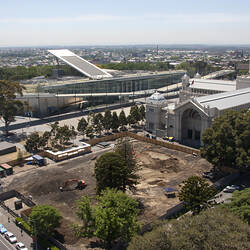Physical Description
One base fragment of an earthenware plate. Pattern is blue transfer print 'Willow'. Manufacturing date range is circa 1805 to circa 1900.
Physical Description
One base fragment of an earthenware plate. Pattern is blue transfer print 'Willow'. Manufacturing date range is circa 1805 to circa 1900.
More Information
-
Collection Names
-
Collecting Areas
Public Life & Institutions, Historical Archaeology, Royal Exhibition Building
-
Acquisition Information
Transfer from Godden Mackay Logan Heritage Consultants (GML), Department of Archaeology, La Trobe University, Australia Gallery, History & Technology Department, Museum Victoria, 20 Nov 2009
-
Manufacture Date
-
Context Number
G12/4/8/009
-
Site
Australia, Victoria, Melbourne, Royal Exhibition Building Western Forecourt
-
Distinguishing Marks
Miller (1991) and Copeland (1994) state that the Willow pattern was standardised in circa 1790, although Klose and Malan (2000) state that this occurred after 1810. Willow was produced by a large number of potteries over a long period and was the cheapest available transfer printed pattern through much of the 19th century. Start date based on start date for production of whiteware.
-
Activity
-
Specific Activity
-
Decoration
-
Colour
Blue
-
Classification
-
Category
-
Discipline
-
Type of item
-
References
Miller 1991: 8; Copeland 1994: 13; Miller et al 2000: 13; Klose and Malan 2000: 55
[Article - Journal] Miller, George L. A Revised Set of CC Index Values for Classification and Economic Scaling of English Ceramics from 1787 to 1880. Historical Archaeology. 25 (1): 1-25., 1991, 8 Pages
[Book] Copeland, Robert. 1994. Spode., 1994, 13 Pages
[Article - Journal] Miller, George L., et al. Telling Time for Archaeologists. Newsletter of the Council for Northeast Historical Archaeology. 29: 1-22., 2000, 13 Pages
[Article - Journal] Klose, J & Malan, A. The Ceramic Signature of the Cape in the Nineteenth Century, with Particular Reference to the Tenant Street Site, Cape Town. The South African Archaeological Bulletin. 55: 49-59., 2000, 55 Pages
-
Keywords
Archaeology, Eating & Dining, Royal Exhibition Building, World Heritage

